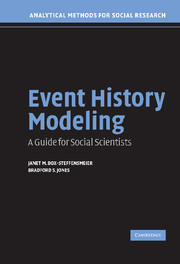The lexicon of event history analysis stems from its historical roots in biostatistics. Terms like “death,” “failure,” and “termination” are natural for analyses of medical survival data, but may seem awkward for social science analysis. In the context of medical research, survival data usually consist of longitudinal records indicating the duration of time individuals survive until death (if death is observed). In analyzing survival data, medical researchers are commonly interested in how long subjects survive before they die. The “event” is death, while the duration of time leading up to the death, the “history,” is the observed survival time. Analysts working with survival data may be interested in assessing the relationship between survival times and covariates of interest such as drug treatments.
Likewise, social scientists frequently work with “survival data,” although such data are generally not thought of in terms of survival and death. Nevertheless, much of the data social scientists use are generated from the same kinds of processes producing survival data. Concepts like “survival,” “risk,” and “failure” are directly analogous to concepts with which social scientists work. Thus, the concept of survival and the notion of survival and failure times are useful starting points to motivate event history analysis.
Event history data are, as Petersen (1995) notes, generated from failure-time processes. A failure-time process consists of units (individuals, governments, countries, dyads) observed at some natural starting point or time-of-origin.
